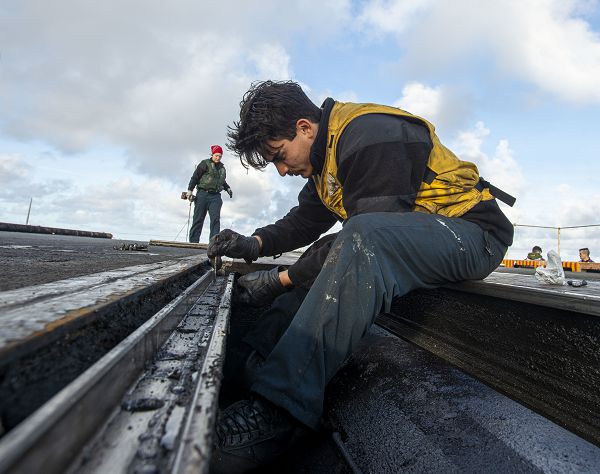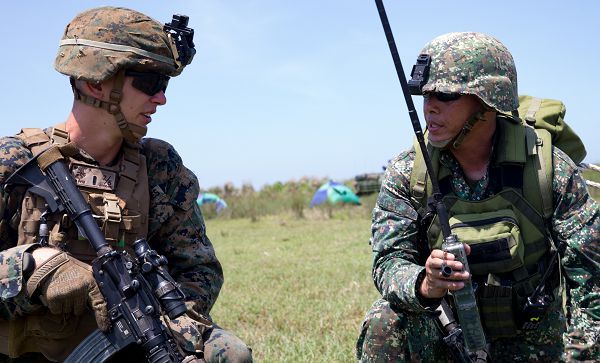- Details
- Hits: 312

Washington, D.C. (November 24, 2023): In this photo by Staff Sergeant Warren Smith, Jack Lowe shows off his Eagle Globe and Anchor signifying his becoming an “Honorary Marine”, an honor he earned for his remarkable resilience. The award recognizes his ongoing fight with Ewing Sarcoma, a rare form of bone cancer, and his extraordinary courage and determination. Mr. Lowe has a long familial history of military service and always dreamed of serving in the Marine Corps.The Honorary Marine program officially began in 1992 under 30th Commandant of the Marine Corps, General Carl E. Mundy, and only seventy-five individuals have been bestowed the honor in the program’s history. The title “Honorary Marine” creates a special bond between the American people and the Marine Corps by recognizing individuals in the civilian community who have made extraordinary contributions to our nation’s defense.
- Details
- Hits: 265

Philippine Sea. (November 16, 2023): For centuries, food has been the obsession of Sailors at sea and a major factor affecting morale. In this photo by Petty Officer 3rd Class Jonathan Estrada Eguizabal, Hospital Corpsman 3rd Class Imani Cothran-Hickman, from Grayson, Georgia, receives a sample of a culinary dish prepared for the final round of a cooking competition on the aft mess decks aboard the U.S. Navy's only forward-deployed aircraft carrier, USS Ronald Reagan.
“How’s the chow?” is a serious question for Sailors and Admirals alike who spend an average of six to eight months a year at sea. The typical U.S. vessel has three messes (or galleys), one for the officers (called the wardroom), another for the senior non-commissioned officers, and a third for lower enlisted personnel.
These dining facilities churn out an astounding 17,000 meals a day to some 5,500 people, around the clock, seven days a week. The one hundred plus cooks and servers, or culinary specialists, ensure the crew’s nutritional needs are met while operating in a high-pressure environment around the clock.
Read more: Culinary Specialists Know The Navy Sails On Its Stomach
- Details
- Hits: 299

Pacific Ocean. (November 18, 2023): Since the 1950s, the Navy has used catapults to launch aircraft from extremely short distances. In the photo by Seaman Apprentice Joseph M. Paolucci , Aviation Boatswain's Mate (Equipment) 2nd Class Evan Valdes, from Surprise, Arizona, lubricates a catapult aboard the aircraft carrier USS Nimitz while underway in the Pacific.
The catapult is a slot built into the flight deck that is connected to a large piston below. The piston is attached to the nose gear of the aircraft using a wire rope, or bridle which runs along a track. Different means have been used to launch the catapult, from gun powder to air pressure, but nearly all carriers use steam power today. Steam systems, however, are massive, inefficient, and their extreme temperatures threaten crew safety.
The Navy is currently fielding an alternative to steam, an Electromagnetic Aircraft Launch System, on the USS Gerald R. Ford, America’s newest and most advanced aircraft carrier. Electromagnetic catapults eliminate the dangers of steam and the need for large boiler rooms aboard ships, freeing up vital space.
The history of these devices’ dates to 1904 when the Wright Brothers used a derrick style catapult to launch man’s earliest successful flights. The first person to catapult from a Navy vessel was Theodore Gordon Ellyson, nicknamed “Spuds,” who was launched from a stationary barge just before World War I.
- Details
- Hits: 340

Pacific Ocean. (November 15, 2023): Help wanted. Candidate must be willing to redirect 2,300-degree jet aircraft exhaust from a tiny hatch on the flight deck of an aircraft carrier. Oh, and did I mention the dangerous streams of dust and debris carried by the turbulent air that threatens you and your fellow Sailors? In this photo by MC2 Craig Z. Rodarte, Aviation Boatswain’s Mate (Equipment) 3rd Class Robert Hill operates the jet blast deflector on the flight deck of the Nimitz-class aircraft carrier USS Theodore Roosevelt while underway in the Pacific.
The jet blast deflector is a safety device operated by a Sailor from a hatch on the flight deck at the rear of the aircraft catapults. It is part of the flight deck so planes roll over the hatch on their way to the catapult. When the aircraft clears the hatch, a heavy panel is raised into position behind it. Other planes can then move into position and begin their final preparations safe from the dangerous jet exhaust.
- Details
- Hits: 308

Naval Education Training Command, Philippines. (November 9, 2023): As tensions between the Philippines and China continue to rise, so too does the importance of the Marine Corps strategy of “Standing In” with our friends in the Indo-Pacific. In this photo by Lance Corporal Christine Phelps, Marine 1st Lieutenant Benjamin Radeff with Echo Company, 2nd Battalion, 5th Marines discusses the next objective with his counterpart, Philippine Marine 1st Lieutenant Barahama during exercise KAMANDAG 2, a bilateral event to maintain readiness.
KAMANDAG 2, or “Cooperation of the Warriors of the Sea”, is an exercise between the Republic of the Philippines and the United States that also includes recent participation from Japan. This Philippine-led exercise features military-to-military exchanges, live fire training, close air support, and a joint amphibious landing. The Marines trained alongside Philippine warfighters in jungle survival, urban environments, and combat life saving techniques.
These Marines may very well find themselves fighting side-by-side should war break out. Under a Mutual Defense Treaty signed in 1951, the United States is pledged to come to the aid of the Philippines if they are attacked and vice versa. This treaty was further strengthened in 2014 when the Philippines agreed to direct access to military facilities under a new Defense Cooperation Agreement. American officials have reassured the Philippines that “an armed attack on the Philippines armed forces, public vessels, or aircraft in the South China Sea would invoke US Mutual Defense commitments.”
As China has expanded its missile technology, U.S. war planners have focused on increasing the standoff range or the distance needed to keep American forces outside the kill zone.
As is typical for Marines, they have a more aggressive strategy.
- Details
- Hits: 390

Camp Pendleton, California. (November 12, 2023): For the Marines, nothing is more important than knowing one’s position, or situational awareness, in a combat zone. In this photo by Sergeant Hailey D. Clay, Marine Corps Corporal Taylor Jenkins, a combat engineer with Littoral Engineer Reconnaissance Team, 9th Engineer Support Battalion, 3d Marine Logistics Group, uses the Android Tactical Assault System (ATAK) to input reconnaissance findings. The ATAK is a tool Marines use to report geospatial information among many other uses that are vital in combat.
Developed by scientists and engineers at the Air Force Research Laboratory, the ATAK gives warfighters up-to-the-second situational awareness including visual displays and other analytics. It enables users to navigate using GPS and geospatial map data overlayed with real-time ongoing events.
These tactical feeds allow precision targeting, detail surrounding land information, GPS navigation, and data sharing. Operators can view the location of other Marines which is a great leap in technology compared to hand-held radio transmissions. The ATAK can be downloaded to a phone, tablet, or handheld device and data can be projected onto a large screen in a conference room. For Marines in the field, the ATAK can be attached to an operator’s forearm, thigh, or chest for hands-free use.


